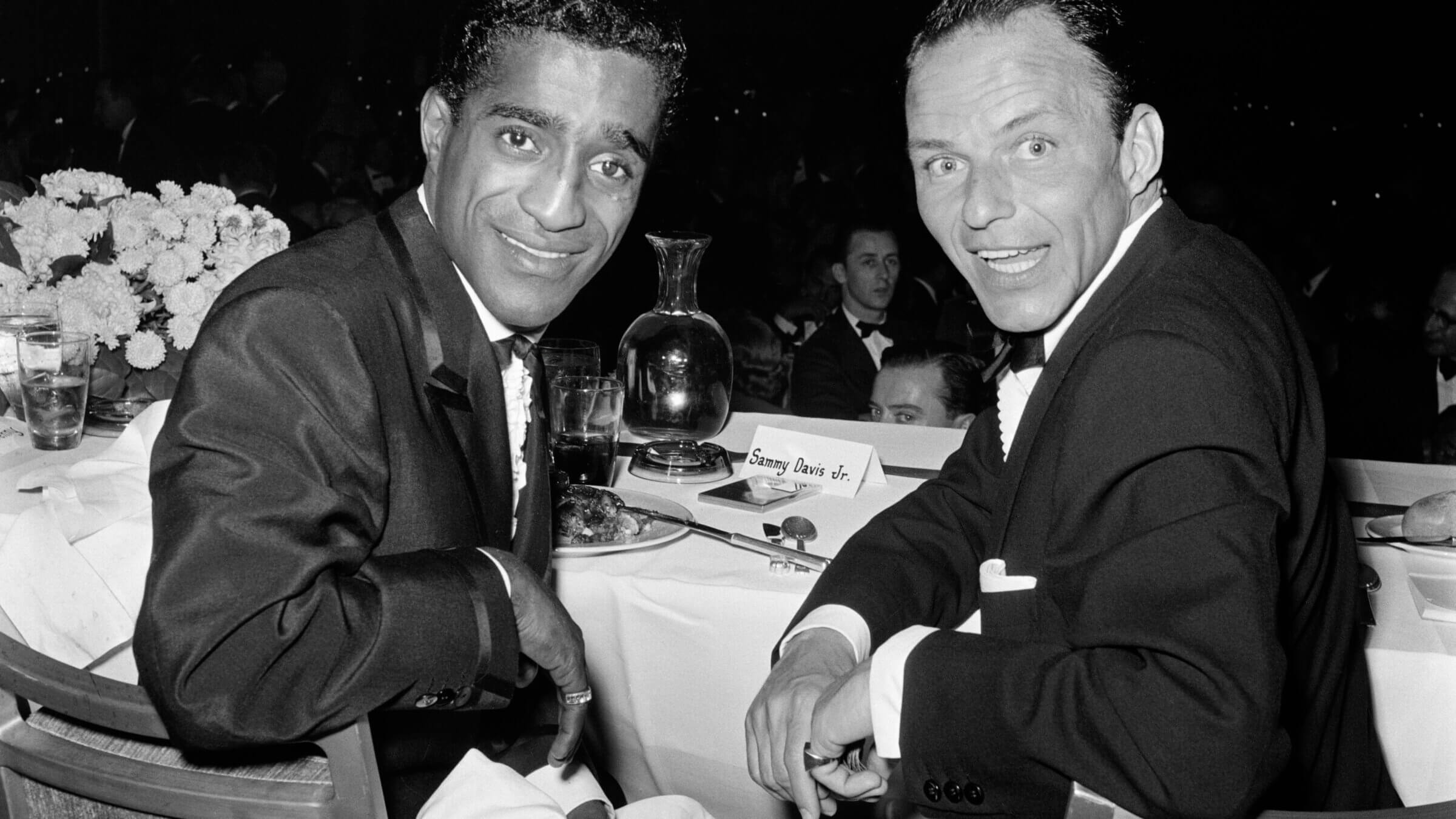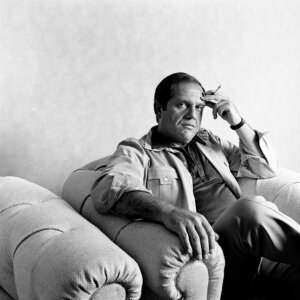Should Jews mourn the loss of the Friars Club?
The onetime haunt of showbiz stalwarts like George Burns and Alan King was auctioned at a foreclosure sale

Sammy Davis Jr. and Frank Sinatra attend a dinner at the Friars Club, 1955. Photo by Getty Images
The news that the Manhattan townhouse occupied by the Friars Club was auctioned on Dec. 10 at a foreclosure sale raises the question of whether some old Jewish social traditions are worth preserving, or are rightly doomed to oblivion.
The Friars Club, welcoming showbiz folk and their fans, was founded in 1904, and although songwriter Irving Berlin (born Israel Beilin) was an early participant, it was not at first mainly a Jewish society. That changed with time. By 1947, when a spinoff Friars Club of California was founded, the architect chosen to design its new home was Sidney Eisenshtat, celebrated for such creations as Temple Emanuel in Beverly Hills, Sinai Temple in Westwood, Temple Mount Sinai in El Paso, and Hillel House on the University of Southern California campus.
As with the last-mentioned edifice, Eisenshtat’s Friars Club, demolished in 2011 despite objections from preservationist groups, combined inner light with a bunker-like exterior offering defense from the outside world.
Indeed, the Eisenshtat Friars Club had no visible windows facing the street, lending an air of mystery to its goings-on. Yet everyone knew that old jokes were being told inside by aging Jews, or at least those who agreed with the basic concept of a mainly Jewish fraternal organization.
Richard Raskin, a historian of Jewish jokes, pinpoints the motivations that led Groucho Marx to quit the West Coast Friars Club, supposedly because he did not wish to belong to any club that would have a nogoodnik like himself as a member.
Misattributed by Woody Allen in Annie Hall to Sigmund Freud’s The Joke and Its Relation to the Unconscious but really deriving from a book by another founder of psychoanalysis, Theodor Reik’s Jewish Wit, the gag as used by Groucho had Friars Club-related motives.
In a 1959 memoir, Groucho admitted that his misanthropy made him shun the “hearty slap-on-the-back” he received at the Friars from “All-American bores.”
Groucho had hoped to find cultured conversations. Instead, some tedious members were “playing gin rummy with marked cards,” others were “shooting loaded dice on a suspiciously bumpy carpet” and still others in phone booths were “calling women who were other members’ wives.” So he wired the Friars membership committee: “PLEASE ACCEPT MY RESIGNATION. I DON’T WANT TO BELONG TO ANY CLUB THAT WILL ACCEPT ME AS A MEMBER.”
Fortunately for the Friars, Groucho’s account was a minority view. In 2000, an informal estimate placed the Jewish membership of the Friars at about 80%.
This included noted Jewish comedians, such as Alan King and George Burns, but also struggling aspirants. It was a place for them to see colleagues and competitors, to kibitz and commiserate over life and career woes.

The Friars Club was a venue for otherwise unengaged Jews to sit and kvetch, like the Stage Delicatessen in the days of its founder, the Russian Jewish restaurateur Max Asnas, as shown onscreen in Woody Allen’s Broadway Danny Rose.
Many gifted, if now unjustly forgotten, comedy minds thrived in the Friars milieu, like scriptwriter Nat Hiken, whose brainchild was The Phil Silvers Show, or actor Phil Foster (born Fivel Feldman) who succeeded late in life when he was cast in the sitcom Laverne & Shirley.
One such slow starter, as the Jewish comic Bobby Ramsen recalled in 2011, was Leonard Gaines, who haunted the Friars Club despite being a nervous failure at standup comedy. Considered by Ramsen to be a professional flop who was nonetheless “hysterical at a table,” Gaines would later write and produce comedy records, including The Shortest Day, a satire of the Six-Day War of 1967. In 1978 Gaines, who had written for Sid Caesar, produced the movie Going In Style starring George Burns and Lee Strasberg, and also appeared as an actor in major films.
In 2012, the impressionist Will Jordan complained to an interviewer that the club was usually underused, except during special events, so it was no longer a hangout for encountering pals serendipitously. Another Jewish comedian, Jack Carter (born Chakrin), observed that whereas in past years Friars events were linked to tzedakah, more recently the public evenings were to benefit the club itself, trying to fill its coffers since membership dues from the older generation of Jewish members were decreasing.
A few loyalists remained, gifted with longevity, such as standup comedian Irwin Corey to cartoonist Al (born Abraham) Jaffee, both of whom attained the age of 102, and the impressionist Larry Storch, who died two years ago at age 99. Yet apart from these shtarkes, in recent years the Friars has mainly been the stomping grounds for cheerful obsessives like Drew Friedman, an American Jewish cartoonist and painter who produced a series of books with slightly scary, hyper-detailed images of old Jewish comedians for Fantagraphics Books, presented at the Friars Club.
In what might be described as a warts-and-all, or indeed only warts, pictorial style, Friedman, a onetime pupil of Will Eisner, Harvey Kurtzman, Edward Sorel, Art Spiegelman, Stan Mack and Arnold Roth, proved himself a worthy son of the energetic American Jewish satirist Bruce Jay Friedman.
Yet this cutting edge, sometimes alarming wit blended with affection, like a Pesach celebrated with sharp tongued mishpocheh, was oddly absent from accounts of the Friars Club celebrations of Friedman’s artistry.
Instead, in 2008 the New Yorker reporter Lillian Ross (born Rosovsky) herself a veteran of an organization that had seen better days, cited a relentless series of overfamiliar gags, presented without comment, although they were mostly more effortful than funny, from speakers of less than urgent interest.
And if the jokes seemed old hat, the societal attitudes were even more so. In 1988, women were belatedly admitted to the hitherto all-male Friars domain, but backward-looking bigotry remained a fundamental feature, especially during roasts and other less formal occasions. The Jewish comedian Red Buttons (born Aaron Chwatt) reportedly was unamused that he was expected to endure endless jibes about the fact that his wife was of Puerto Rican origin.
In 1993, some widespread objections were heard at a New York Friars roast of Whoopi Goldberg in which her then-boyfriend Ted Danson appeared in blackface and used racial slurs. In her own defense, Goldberg explained with some hyperbole that “for 89 years, the Friars have been doing this” and besides, the roast was “never meant to be a public forum.”
Whether in private or public gatherings, present and future generations of Jews interested in comedy may find other welcoming, more open-minded and less hidebound, locales to gather in. Perhaps virtual reality will be the next trend, where young Jewish comedians might encounter Nat Hiken or Phil Foster, but never Groucho, in some Edenic ideal of a social organization for tummlers.

















